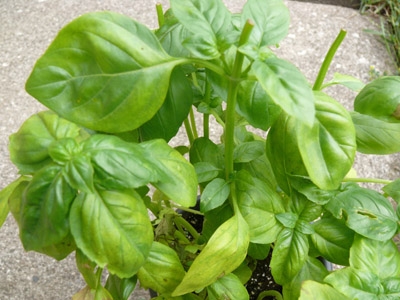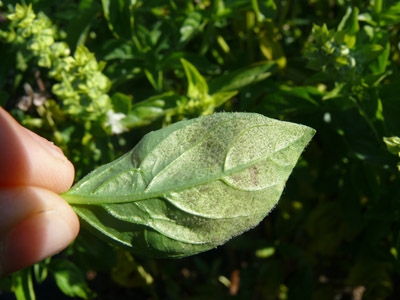Basil downy mildew in herbs
Learn cultural management strategies that may help to reduce or delay the development of basil downy mildew in herbs.
There have been a number of reports of basil downy mildew in the northeastern United States, including Rhode Island, Maine, New Jersey and New York. While there have been no confirmed reports from Ontario yet, herb growers should be actively scouting fields for this disease, as basil downy mildew spores can be spread great distances on wind. The recent rainy weather is favourable to the development of many diseases, including downy mildew.
Downy mildew is a relatively new disease of field and greenhouse basil in North America and is caused by the water mould Peronospora elbahrii. Initial symptoms include general leaf chlorosis (Figure 1) and stunting. Symptoms may superficially resemble a nutritional problem; however plants infected with basil downy mildew typically have a characteristic sporulation of the fungus on the lower leaf surface (Figure 2). Also, the leaf chlorosis, or yellowing, of infected leaves is initially confined to sections of the leaf bounded by the veins, whereas a nutritional disorder would typically affect the entire leaf. Check the underside of leaves for the production of purplish grey spores, which can appear as a fuzzy, granular growth to the naked eye.


The cyazofamid products Ranman 400 SC or Torrent 400 SC and the phosphorous acid products Confine Extra or Winfield Phosphite Extra are now registered for control of basil downy mildew in conventional pest management systems. Refer to the product labels for application and resistance management instructions. There are no organically acceptable pest control products currently registered in Canada for management of basil downy mildew and research done by the University of Guelph suggests that many organic fungicides do not significantly reduce severity of this disease.
Several cultural management strategies may help to reduce or delay the development of basil downy mildew. These include:
- Planting in an open site, exposed to prevailing winds, which can sometimes delay onset of the disease.
- Use of wider plant spacing to promote airflow around the plants, provided that weeds are controlled between the plants.
- Avoiding overhead irrigation, especially after the middle of July.
- Avoiding collection of seeds from basil fields where downy mildew has occurred.
- All varieties of sweet basil have been found to be susceptible to basil downy mildew, however in a University of Guelph trial some varieties had lower levels of infection. Under high disease pressure, the sweet variety "Medinnette" was less infected than other sweet basils, as was the purple variety "Purple Ruffles". All Genovese-type basil varieties tested were very susceptible to the disease.
- Spice type basils are the only varieties that did not develop symptoms in Ontario trials, however their culinary properties are very different from sweet basil varieties, and they likely will not be an acceptable alternative for most growers.
- Consider harvesting basil shortly after downy mildew symptoms are observed, because the crop will likely be unmarketable within a few weeks. However, remember that it can take a week for symptoms to develop, so seemingly healthy leaves at harvest may develop symptoms post-harvest. This should not be an issue for dried basil as long as drying occurs as soon as possible after harvest.